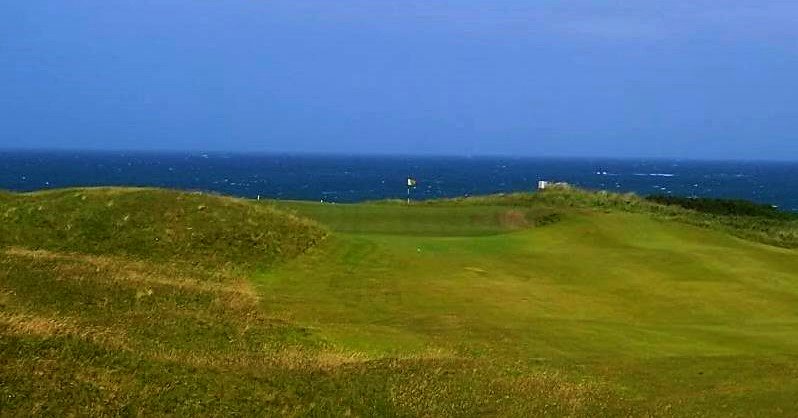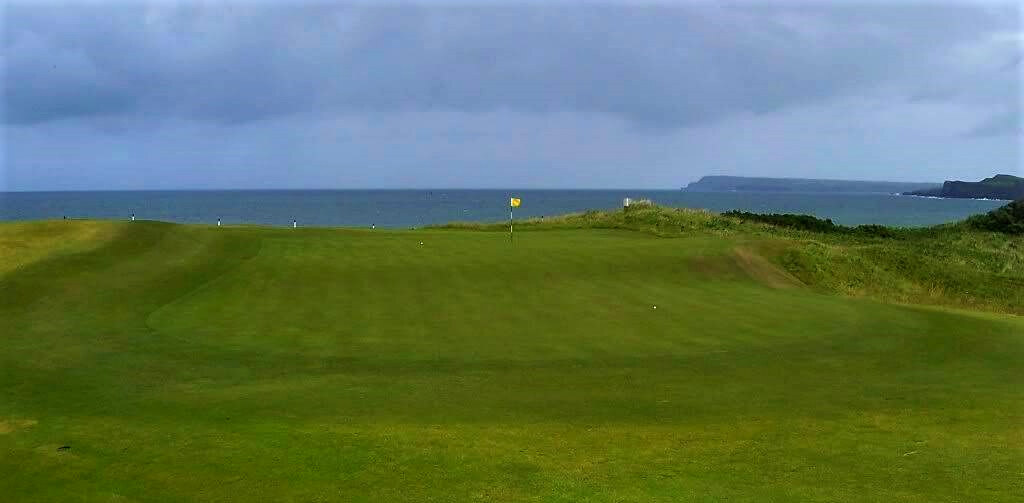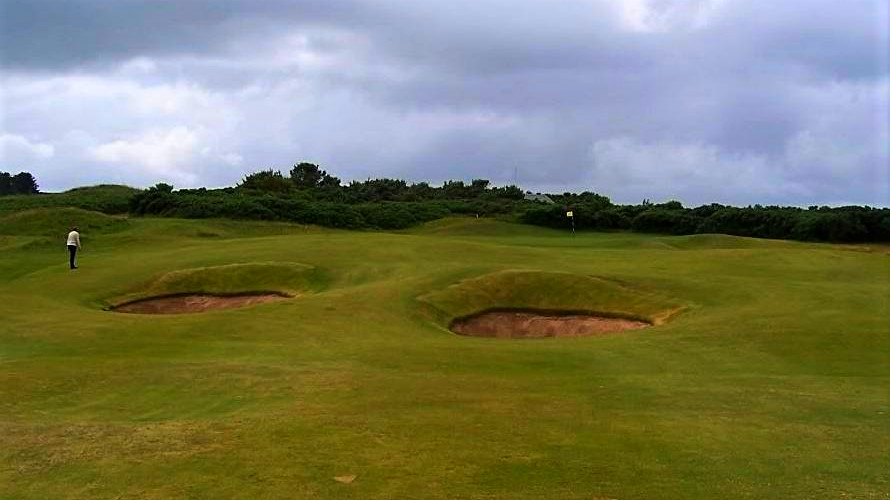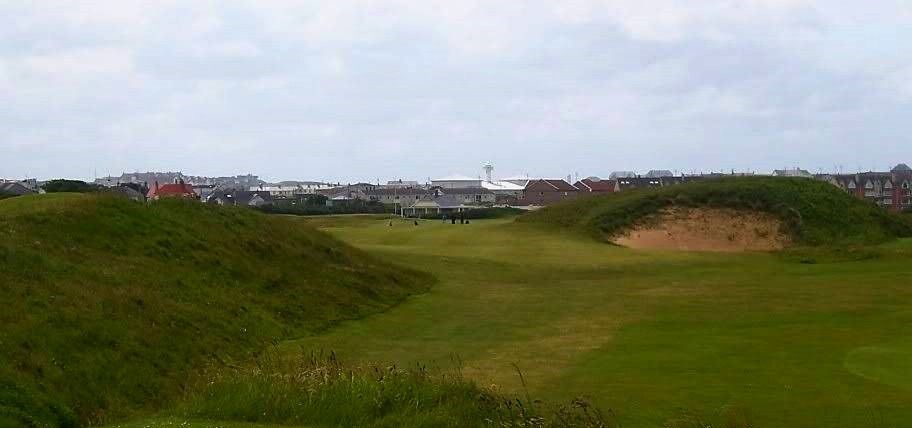This was my first visit back to Portrush in what must be 10 years, if not more. It was surprising that I remembered so much of the course as I hadn't remembered some eight holes at nearby Portstewart. My impressions of the RPD have altered a bit as I figured out what makes the course so tough. Many blame the Sargassian rough combined with the relatively narrow fairways. Of course, this is part of Portrush's difficulty. However, I think the real issue is the cross wind holes and in this way Portrush can be compared to Birkdale. #s 5 through 15 tend to have a westerly wind cross them off the left or right making the fairways (of which many turn at the driving zones) very difficult targets to hit, especially when several have ideal landing zones which are hidden. #s 1-4 and 16-18 normally play against or with the wind making these the holes which the player must take advantage of or suffer a long demoralizing day.
Despite the difficulty, even with a not too terrible 15-20 mph wind and from the forward (6400 yard) tees, Portrush is a special course and one of Colt's best efforts. I was asked to choose between the Dunluce and Co Down and while I don't think there is anything between the two my preference is for the Dunluce. While the fairways are bit too narrow, that in no way takes away from the clever routing which not only gets the best out of the rows of dunes perched high above the sea, but also the wind. I know the club is keen to host the Irish Open and has added yards to their championship tees which now total some 7000+ yards. This is a trend I disapprove of, but on the other hand I can see why this magnificent course should be show cased.
The first is a lovely opener which would grace the best of courses, yet at Portrush its just another hole which doesn't particularly stand out. OOB is down the right and left though to be honest, if you go that far left the ball will likely never be seen again. Unfortunately, the obligatory caravan park rears its ugly head on the first few holes and once or twice in later holes. One will notice that the bunkering is fairly light and that none are revetted. The course wasn't playing particularly keen, even so one must take care with the approach so as not to go long if the intention is to fly the green.

A reachable par 5, the driving zone for the second is narrow. Below are the bunkers which must be flirted with to reach in two.

The short knob to knob third.

The course starts to really pick up with the 4th. This is one of the more clever holes because the obvious looking play is to take on the OOB right for the angle to the green...

...however, a layup short of the centre-line bunkers still leaves the option of using the contours on the right edge of the green to swing balls well to the left.

As stated previously, the following eleven holes essentially are what make Portrush's reputation as a difficult course. The 5th is one of those snaking par 4s in which the ideal line is further left than we WANT to play. One can also sling a wind assisted fade around the dune and gain the ideal line of approach without risking the long carry. From the perfect position the approach is still not easy. You have to scoot one up the green as very few players have the ability to hold the back tier.


I am very impressed with the old time tee markers which act as rubbish bins and bag stands, but that isn't why I took the photo. I snapped this shot because I thought it unusual that a par 3 would be named after the archie except in the case of Colt. That said, I don't think Portrush's short holes are Colt's best effort. All are good without being brilliant - Calamity Corner excepted of course.

From well in front of the tee we can see the classic use of dead ground.

These shelters are common on both Portrush courses and Portstewart. They are also dead give-aways as to the general direction of prevailing wind.

The 7th is a particularly difficult fairway to hit as it is obscured and twisting at the landing zone. Here is a good look which shows the scale of the rolling dune-land. Many spots leave blind approaches.

A relatively new hole, the 8th was built before WWII (but opened after the war). A severe arching legger to the right, the ideal landing zone is blind and one can get there with a long carry or hit a fade which turns with the wind. One can see that hole continues to turn right through the green.

Like the 8th, number 9 was opened in 1945. The hole offers a bit of respite as it is a short par 5, but the carry to the fairway can be daunting! The green sits on a plateau with dead ground as its main defense. The respite continues with the short par five 10th. Yet again, the drive is very difficult. Despite the shortness in yardage, these par 5s are difficult to reach. The green is typical of most at Portrush, there is some undulation, but the main elements of defense are the cant of the greens and their shedding nature. In some sense, Portrush is very much a modern links built to test all facets of the player's game. The number of bunkers and their placement signal when Colt thought the natural shot on offer was too forgiving....the 10th.

...and short 11th.

The 12th is another hole which relies on the wind to cause trouble. Bunkers are placed on the right side of the fairway prompting players to aim well left and hope the wind doesn't work the ball back too far right. The green requires a precise approach. Any weak efforts will fall off this turtleback green.

One of my favourite holes, a good tee shot up the hill is required to earn a view of the green. Once on top of the hill a glorious view is on offer. The green doesn't want to receive the approach and anything less than a true strike will likely slide away. #13.

Calamity Corner.



15 leads to a green which lays directly behind the 11th. This is a strange hole and a bit out of character with the remainder of the course, but it is fun and much harder than it appears. I was tempted to hit a putter from this spot.

One of Portrush's brutes, the 16th plays straight back into the wind, but a huge (for Portrush) fairway awaits. It is best to keep left for a view of the green. The cross bunkers are the over-riding concern for the approach as reaching the green is quite difficult. As can be seen from this photo, the hole widens back out around the green and the bunkers are well short of the green, yet perfectly placed when the wind is factored in. This hole doesn't get mentioned much, but I have a lot of time for it.

Its a great pity this bunker isn't more in play because the 17th does need a bit of spice. On a side note, is there another course in the world which shares a fairway with a hole from a different course? The Valley Links 2nd fairway is just to the right of the big bunker and runs just below the 17th tee.

The home hole swings back on the 17th. I found this hole to be very un-Colt-like. To take advantage of the left to right swing of the enormous green, the best angle of approach is from the right, but a host of bunkers eliminates this possibility. Furthermore, if one does thread it up the left there is a cross bunker awaiting.
Despite the narrowness of the course which can threaten to take away some of the joy of the game, Portrush can't be dismissed lightly. The quality and variety of the holes throughout are of an exceptional standard and there are a few holes which standout out as All-Ireland candidates. All lovers of Colt, links and championship golf should play Portrush. It should be pointed out that two new holes were built for the 2019 Open. The old 17 & 18 were replaced by new holes created from 5 & 6 of the Valley Links. These are now 7 & 8 on the Dunluce. The course then goes back to the old 7th as the new 9th etc. 2* 2009
Ran's Review.
http://golfclubatlas.com/courses-by-country/northern-ireland/royal-portrush-golf-club/Valley Links
www.golfclubatlas.com/forum/index.php/topic,40282.msg846630.html#msg846630Ciao